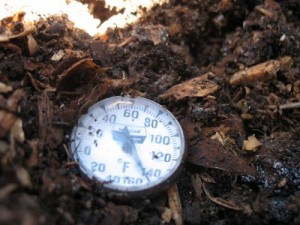How to Create a Hot Compost Pile
 Question:
Question:
I have a compost pile and nothing I do heats it up. What could be the matter with it?
Answer From Pat:
If you have already read and are following the instructions on compost in my book (pages 97 to 99 and other references in index. Also the chapter in my memoir “All My Edens” called “Romancing the Compost Heap”) and composting still doesn’t work for you, here is my estimation of the problem. First it really would help if you gave me a little more information on such items as the size of your compost pile (for hot compost 3 feet X 3 feet x 3 feet is best) and your method of composting or what you have put into the pile. Without knowing all that it is a little difficult for me to provide accurate advice, but I certainly can guess what the problem might be. So here goes:
If a gardener has a compost pile that never heats up nine times out of ten the cause is one of two problems. The first problem is that the compost pile is being kept too dry or too wet. Wet sloppy piles cannot heat up. Wet piles are sometimes putrid and smelly. This means too much nitrogenous waste has been added. Fix this by adding a few wood shavings (carbonaceous waste.) But dry piles without adequate moisture can’t heat up either. You need to keep the pile properly moist and spongy, not soppy wet. Also, a dry pile that is moist on the inside and cooking on the inside can catch fire so one does need to monitor compost piles and toss and turn them so you put the dry stuff inside and mix the inside to the outside again to cool the pile and keep it cooking.
Another major problem folks often have is that the pile contains too many dry woody ingredients (carbonaceous materials) and not enough nitrogenous waste. Nitrogenous waste is like sloppy garbage left from veggies and fruits at the kitchen sink or it is manure or grass clippings or wet green stuff from the garden. (For more details see my fertilizer chart on my website and also my soil amendment chart on page 28 of my book.) Woody ingredients are dry wood, dry leaves and twigs and left-over plant materials like corn cobs. (These are difficult or impossible to compost). All the leftover at the end of the veggie season, the plant matter may be dry by the time you pull it out, chop it up, and compost it. You will need a lot of nitrogenous ingredients, like soft green leaves of tomato plants, to heat up these layers of carbonaceous ingredients.
Then if you want to create a hot pile and not a slow pile you also need to toss and turn the pile to keep air in there, to cool the pile if it gets too hot or to heat it up again if it begins to cool down. This is a lot of work and I personally can’t do it myself, so there are other ways to do this, such as the drums companies sell for composting. When you use a drum you need to follow the instructions that came with it exactly and also you need at least 2 of them or even 3 of them or you will be continually adding more ingredients while it’s cooking. That’s not the right thing to do. When creating hot compost the fast-composting way, you want to make just one pile at a time and then let it work.
Slow composting is different. You just pile stuff up and keep it moist and make sure there are no tree roots in it and eventually you will get lovely compost out of the bottom and this kind of pile can be any size. I have written about this many times. (See both books and other places on this website.)
If the problem is too much carbonaceous waste and not enough nitrogenous waste, and this is usually the problem when compost doesn’t “cook”, my recommendation is to use human urine to heat up the pile. Just pee in a bucket and pour it straight onto the compost and keep the compost damp with water from the hose and you will get a nice hot compost pile. Then toss and turn it. Human urine is clean healthful stuff and a great source of nitrogen. (It also contains phosphorus and potassium. See comments on page 32 of my book and on my fertilizer chart.) Just pee in a bucket or (If you are a man) straight onto the compost and that will heat up the pile eventually. This is the organic way. (The inorganic, synthetic fertilizer way is to add sulfate of ammonia to compost to heat it up, but as organic gardeners we don’t use synthetic fertilizers.) Of course, you could use blood meal, but blood meal comes from cattle and some folks don’t like using it. Also it’s expensive. Why spend money when you are throwing a perfectly good, free nitrogen source down the drain? Urine contains salts but you will be adding enough water from the hose to wash out most salts. And by the way, human urine makes great rose fertilizer. Just dilute it 8 or 10 to one with water. Pour it on the ground, not on the foliage, and continue to irrigate roses regularly to wash out the salts. You will have super roses. (You can use the stuff straight as a weed killer so remember to dilute it well when using as fertilizer.)

